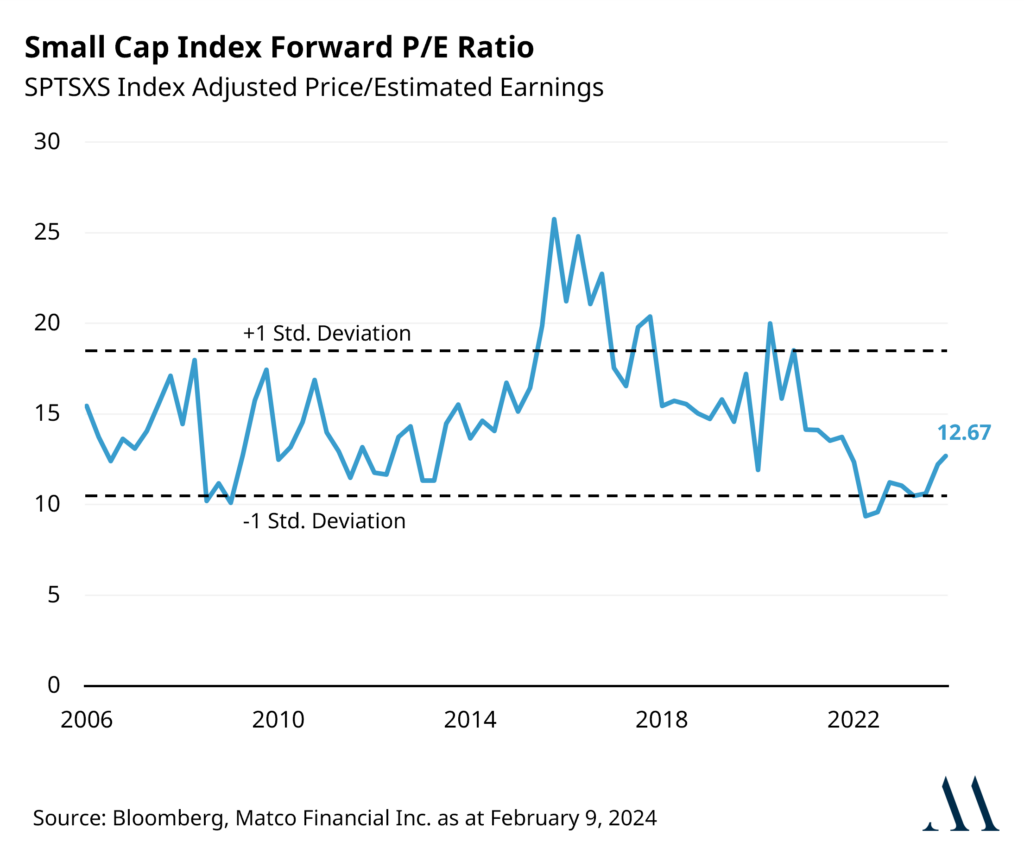
The Next Big Thing
February 14, 2024

February 14, 2024

With investors captivated by the glitz of mega-large cap technology stocks and the A.I. revolution, it’s easy to overlook the underdogs of investing—small-cap stocks. As we pivot towards looking for value in an overvalued market, these smaller players are positioned centre stage and could surprise to the upside. Here’s why the next big thing in investing might just be going small.
Peak Interest Rates: With signals from the U.S. Federal Reserve and the Bank of Canada hinting at a peak in interest rates, it looks promising for small-cap companies, although the timing is uncertain. Typically more leveraged, these firms stand to benefit from reduced interest rates, potentially boosting their profit margins and, by extension, their stock prices. Especially for Canadian small- and mid-cap companies, anticipated interest rate cuts could serve as a powerful tailwind.
Attractive Valuations: Small-cap stocks are trading at a significant discount compared to their large-cap counterparts. For instance, the TSX Small Cap Index’s price-to-book value is trading at 0.65 times the value of the TSX Composite Index and has been one standard deviation below its mean of 0.79 since 1999. In addition, Canadian small-cap stocks are trading at a forward price-to-earnings ratio at one standard deviation below their mean (see graph below). Small-cap stocks have lagged large-cap stocks in the U.S. for seven consecutive years. They are now trading at a price-to-earnings valuation gap two standard deviations below the S&P 500 Index, an anomaly not since the Internet bubble of 2000.

Flying Under the Radar: The majority of investors tend to shy away from small-cap companies, often due to their lesser-known status. This oversight creates a ripe field of untapped potential, offering patient investors the chance to capitalize on market inefficiencies for outsized gains.
Large Opportunity Set: The sheer number of publicly traded small- and mid-cap companies in Canada and the U.S. outnumbers their large-cap peers. They represent a broader spectrum of investment opportunities. Navigating this extensive landscape requires diligent research and due diligence, which many investors constrained by time and resources often bypass.
A Stock Picker’s Market: Unlike large caps, whose earnings are closely tied to the economic cycle, small- and mid-cap companies often have unique growth catalysts. Identifying these drivers demands a deep dive into each company’s operations and strategies with the management team—a rewarding endeavour for those able to invest the effort.
We believe that the markets are currently positioned for a shift towards small- and mid-cap stocks. With economic indicators signalling strength and lower interest rates on the horizon, diversifying your portfolio into an actively managed small-cap fund would be wise for investors seeking value in an increasingly overvalued market. Your level of exposure is a function of your risk tolerance and investment time horizon.
The Matco Small Cap Fund exemplifies this opportunity with its fundamental bottom-up approach and focuses on companies with robust financials and growth catalysts. January’s performance alone—with a 4.1% increase—underscores the potential in well-selected small-cap investments.
In the words of Wayne Gretzky, “I skate to where the puck is going to be, not where it has been.” As we navigate the markets in 2024, it may be time for you to consider where the puck is heading next—toward the promising arena of small-cap stocks.
If you are intrigued by the prospect of adding small caps to your portfolio, reach out at atahiliani@matcofinancial.ca for more insights or to discuss how this strategy aligns with your investment goals.

delivered to your inbox once a month